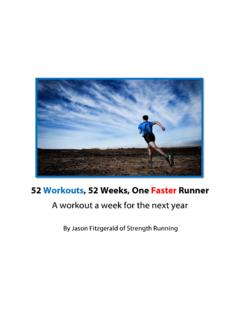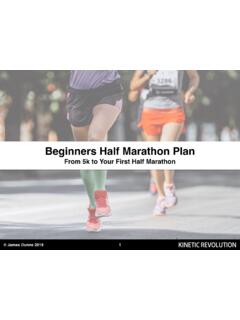Transcription of 52 Workouts, 52 Weeks, One Faster Runner - Strength …
1 52 workouts , 52 weeks , One Faster Runner A workout a week for the next year By Jason Fitzgerald of Strength Running You Know Better, But I Have to Say it: You should consult with your primary health care physician before beginning any nutrition or exercise program. Use of the programs, advice, and other information contained in this guide is at the sole choice and risk of the reader. Now, let s get to the fun stuff. This guide is free and does not contain any affiliate links. Share it with the world under the terms of the Creative Commons Attribution license. 2011 Jason Fitzgerald What are your goals? Qualify for Boston Race a local 5k Run your first half- marathon Become a minimalist Runner Set a new 10k PR Run your first trail race Whatever running aspiration you have, this guide can help you achieve your goals.
2 Table of Contents About Me Why did I write this? How to use this book Endurance is King Developing Top End Aerobic Power Primal Sprinting: Distance Runners Need Speed, Too Fartlek Workouts (Skip the Track) Hills = Strength Boarding the Pain Train: Interval Workouts Fun Runs, With or Without a Group About Me I ve been running for over 12 years and have competed in everything from the 200m to the marathon . I m not the fastest guy out there, but I ve had some success. I started running cross country in 1998 as a freshman in high school. I barely finished 3 miles and then couldn t walk for a week . I stuck with it and also ran track. My senior year I was Captain of the cross country team and ran fast enough for it to help me get into college. At Connecticut College I started running 80-90 miles a week with tough workouts and 8k cross country races.
3 The injuries started immediately. I still managed to run 26:19 for 8k cross country and finish top 10 in New England for the 3k steeplechase. After college, I was still getting hurt: achilles tendonitis, lower back pain, quad strains, and plantar fasciitis. Still, there are some races I m proud of. I ran 1:13:39 for the half- marathon and 54:50 for ten miles. I did a few sprint triathlons and ran 10k cross country in 33:41. I also ran my first marathon at New York in 2:44:38. I m most proud of this race because of the six months of preparation and the effort it took. After the marathon , I couldn t run for six months because of a severe illiotibial band (ITB) injury. I devoted those six months to learning how to injury-proof my body. Since I overcame my ITB pain. Small aches and pains happen, but I haven t had a major injury since the Spring of 2009.
4 In 2010, I won 4 races more than any other in my 12+ year career. I ran more mileage in 2010 than any other year (with no serious injuries). I decided to share my journey and everything I ve learned on my running blog and coaching site, Strength Running. Why Did I Write This Guide? My training philosophy is very different now than what it used to be. I m having more fun, training harder, and getting injured less. This is what running should be like. I do things much differently than before, and a big part of that is in the workouts that I run. I run a lot of different types of workouts these days. One of the hallmarks of my new training is that I include a lot of variability. I run lots of different paces, workouts, and terrain in training . Different paces and workouts stress your body in different ways. By varying those stresses, you re not relying on the same muscle groups at all times.
5 Flat roads will require a different effort than hilly trails. The same is true for a track workout as opposed to a fartlek over rolling terrain. Alternating the types of workouts you do can help you reduce your injury risk, make you a more efficient Runner , and improve your outlook on training (who gets bored doing a different workout every week ?!). That got me thinking how many workouts do I know about? I started keeping a list, and before I knew it the list had grown to over 40 workouts. With a little more thought, I expanded the list to 52 workouts . That s a different workout for every week of the year. I want this list of workouts to help you get out of a rut. I want to help you get excited about running again. I want to challenge you. I want to give you workouts that will transform your training . I want you to run more. I want you to a personal best.
6 How to Use This Book You shouldn t do the workouts in this book every week for a year. Every workout has a purpose and your training wouldn t be very cohesive if you did that. Instead, pick and choose workouts from each section based on your goals. Each section will have a different focus, from sprints to long runs and even barefoot running. Some of the workouts are incredibly challenging and you may not want to attempt them. Others are quite easy (and that s often the point). Feel free to mix and match workouts. You can do more or less depending on your fitness level. No running program is set in stone and you can edit a workout as much or little as you want to. The only limit is your creativity. Use these workouts as inspiration to work hard toward your goal. Make sure to have fun. Part I Endurance is King Developing Aerobic Power No one will burn out doing aerobic running.
7 It is too much anaerobic running, which the American scholastic athletic system tends to put young athletes through, that burns them out. Arthur Lydiard These workouts are designed to maximize your aerobic potential and develop lasting endurance. They re long. They re hard. But they will make you stronger than you ever have been. Workouts will include long runs, tempos at your lactate threshold, marathon pace runs, and longer fartleks. I think everyone should do a long run, but these are geared for anybody training for longer distances ranging from 10 miles to the marathon . These workouts will give you the stamina to dominate your next race. As you read through this section, you ll notice I reference tempo pace a lot. Tempo pace is your lactate threshold pace, or the maximum speed you can run for about an hour. It will be anywhere from your 10k race pace to your half- marathon pace and will be 85-90% of your maximum heart rate.
8 After doing these workouts, you won t be worrying about being able to finish. You ll be worrying about how fast you re going to negative-split the second half. Up-Tempo Long Run The up-tempo long run is a challenging long run at a Faster pace than your typical distance run. After a 2-3 mile warm-up, start running 20-30 seconds per mile Faster than your normal running pace. This workout shouldn t be done every week but provides a stronger aerobic stimulus than running easy. You should already be comfortable with your long run distance before running it Faster . Progression Long Run The progression long run ends with 2-5 miles significantly Faster than your standard distance running pace. You will be running at your tempo pace, or even a little Faster , at the very end of the progression. At the start of the progression, you increase your pace by 20-30 seconds per mile and gradually get Faster .
9 You can end as fast as you like, but if you end the run very fast then you should do 5-10 minutes of easy running as a warm-down. To use me as an example, I like to do 3 miles of progression running at the end of long runs. My typical distance running pace is about 7:00 per mile, so my progression mile paces would usually be about 6:30, 6:00, 5:40. Long Run with Speed Bursts This type of long run is one of my favorites because it s highly beneficial, but not that difficult to complete. During the last 1-2 miles of your run, run several surges at a much Faster pace. They can be anywhere from 15 seconds to a full minute and be as fast as a full sprint or as slow as your 5k pace. Jog for 30 seconds to 2 minutes in between each mini-interval. You can do as many or as few as you like I prefer 4-6 reps, depending upon the length of the interval.
10 These short bursts help you develop a quick turnover when you re already tired. With a full jogging recovery, they shouldn t be too difficult, plus they ll give you something to look forward to at the end of your long run. Long Run ending with MP Finish I personally used this workout as my standard long run when I got ready for the New York marathon . It s very difficult and teaches your body how to run fast when you re already tired. Since the pace should be as close to your marathon pace as possible, I prefer running the last 3-6 miles on the track. Start at your goal marathon pace and run as even as possible for the remainder of the effort. For added difficulty (once running even is manageable), negative split each mile by 2-5 seconds. Since you ll be finishing at a track, you either need a track in your backyard or will need a friend to pick you up (with recovery fuel, of course).




